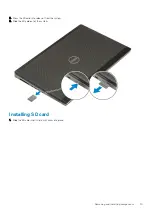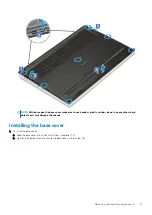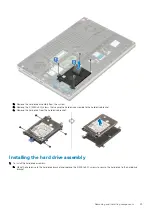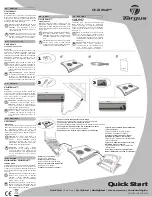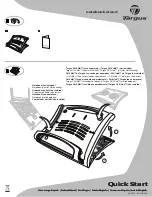
Technology and components
This chapter details the technology and components available in the system.
Topics:
•
•
•
HDMI 2.0
This topic explains the HDMI 2.0 and its features along with the advantages.
HDMI (High-Definition Multimedia Interface) is an industry-supported, uncompressed, all-digital audio/video interface. HDMI provides an
interface between any compatible digital audio/video source, such as a DVD player, or A/V receiver and a compatible digital audio and/or
video monitor, such as a digital TV (DTV). The intended applications for HDMI TVs, and DVD players. The primary advantage is cable
reduction and content protection provisions. HDMI supports standard, enhanced, or high-definition video, plus multichannel digital audio
on a single cable.
HDMI 2.0 Features
•
HDMI Ethernet Channel
- Adds high-speed networking to an HDMI link, allowing users to take full advantage of their IP-enabled
devices without a separate Ethernet cable
•
Audio Return Channel
- Allows an HDMI-connected TV with a built-in tuner to send audio data "upstream" to a surround audio
system, eliminating the need for a separate audio cable
•
3D
- Defines input/output protocols for major 3D video formats, paving the way for true 3D gaming and 3D home theater applications
•
Content Type
- Real-time signaling of content types between display and source devices, enabling a TV to optimize picture settings
based on content type
•
Additional Color Spaces
- Adds support for additional color models used in digital photography and computer graphics
•
4K Support
- Enables video resolutions far beyond 1080p, supporting next-generation displays that will rival the Digital Cinema
systems used in many commercial movie theaters
•
HDMI Micro Connector
- A new, smaller connector for phones and other portable devices, supporting video resolutions up to 1080p
•
Automotive Connection System
- New cables and connectors for automotive video systems, designed to meet the unique
demands of the motoring environment while delivering true HD quality
Advantages of HDMI
•
Quality HDMI transfers uncompressed digital audio and video for the highest, crispest image quality.
•
Low -cost HDMI provides the quality and functionality of a digital interface while also supporting uncompressed video formats in a
simple, cost-effective manner
•
Audio HDMI supports multiple audio formats from standard stereo to multichannel surround sound
•
HDMI combines video and multichannel audio into a single cable, eliminating the cost, complexity, and confusion of multiple cables
currently used in A/V systems
•
HDMI supports communication between the video source (such as a DVD player) and the DTV, enabling new functionality
USB features
Universal Serial Bus, or USB, was introduced in 1996. It dramatically simplified the connection between host computers and peripheral
devices like mice, keyboards, external drivers, and printers.
2
8
Technology and components















